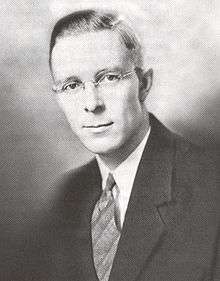Alberta general election, 1955
| |||||||||||||||||||||||||||||||||||||||||||||||||||||||||||||||||||||||||||||||||||
61 seats in the Legislative Assembly of Alberta 31 seats were needed for a majority | |||||||||||||||||||||||||||||||||||||||||||||||||||||||||||||||||||||||||||||||||||
| |||||||||||||||||||||||||||||||||||||||||||||||||||||||||||||||||||||||||||||||||||
| |||||||||||||||||||||||||||||||||||||||||||||||||||||||||||||||||||||||||||||||||||
The Alberta general election of 1955 was the thirteenth general election for the Province of Alberta, Canada. It was held on June 29, 1955 to elect members of the Legislative Assembly of Alberta.
Despite losing almost 10% of the popular vote (compared to its 1952 proportion of the vote) and 30% of its seats in the legislature, the Social Credit Party, led by Ernest C. Manning, received a slightly higher number of votes than in 1952 and won a comfortable majority for its sixth term in government.
The Liberal Party emerged as the principal opposition to the Social Credit juggernaut, winning over 30% of the popular vote, and increasing its legislative caucus from 4 members to 15. The Cooperative Commonwealth Federation won two seats however leader Elmer Roper was defeated ending his thirteen-year career in the legislature. The Conservative Party and various independents also won seats.
Snap vote
The 1955 election was brought on after Liberal leader James Harper Prowse questioned the confidence of the government in question period regarding members of the Social Credit caucus who had had dealings with the Alberta Treasury Branch. Manning was angered by the question and had the Lieutenant Governor dissolve the assembly despite having two more years left in his term.
Expulsion
On the last day of the campaign Ernest Manning barred candidates Roy Lee and John Landeryou from running as official Social Credit candidates. However, due to the ballots having already been printed, the two men were still listed under the Social Credit name. Lee and Landeryou had violated the Legislative Assembly Act by renting a building to the provincial government.[1]
End of STV and AV
Following this election, the Social Credit government did away with the Instant-runoff voting system, that had been in place in the rural constituencies, and the Single Transferable Vote system in Edmonton and Calgary, both of which had been in place since 1924. The move was made to standardize and simplify voting results across the province. Under single transferable vote, results would take up to five days to count all the possible vote transfers, before anyone was declared elected. This was especially problematic, in Edmonton that elected seven members.
As well, the government in 1955 had lost five local elections in rural constituencies due to the IRV, when its candidate had received the largest portion of the vote in the first round but was not elected to the seat after re-distribution of the ballots in the second round. The cancellation of the IRV system was meant to prevent this in the future.
There were five constituencies where the SC had the largest number of first-choice votes but were not elected in the second round ballot count. One historian has stated that there were 20 constituencies like this in which the SC at the end won only five but that number is too high. There were 16 constituencies in which, in the first round, no candidate took the majority of the votes. In these constituencies, second round balloting (through re-distribution of some of the voters' second preferences) was held. Mostly the candidate leading in the first round won the seat in the second round, but there were five constituencies (Acadia-Coronation, Athabasca, Grouard, Lac Ste. Anne and Vermilion) in which the leading candidate in the first round did not win the second round (thus the seat), and the victim in all five cases was the SC candidate, indicating to the government that the supporters of the opposition parties were beginning to support each other in a joint effort to defeat the government.
Results
| Party | Party Leader | # of candidates |
Seats | Popular vote | |||||
|---|---|---|---|---|---|---|---|---|---|
| 1952 | Elected | % Change | # | % | % Change | ||||
| Social Credit | Ernest C. Manning | 62 | 53 | 37 | -30.2% | 175,553 | 46.42% | -9.82% | |
| Liberal | James Harper Prowse | 53 | 3 | 15 | +400% | 117,741 | 31.13% | +8.76% | |
| Conservative | John P. Page | 26 | 2 | 3 | +50.0% | 34,757 | 9.19% | +5.52% | |
| Cooperative Commonwealth | Elmer Roper | 38 | 2 | 2 | 0% | 31,180 | 8.24% | -5.81% | |
| Coalition | Frank Gainer | 2 | * | 1 | * | 4,581 | 1.21% | * | |
| Independent | 7 | - | 1 | 4,225 | 1.12% | +0.88% | |||
| Liberal Conservative | Ross Ellis | 2 | * | 1 | * | 4,001 | 1.06% | * | |
| Independent Social Credit | 3 | 1 | 1 | 0.0% | 2,721 | 0.72% | -0.69% | ||
| Labor–Progressive | 9 | - | - | - | 3,420 | 0.90% | +0.52% | ||
| Total | 202 | 60 | 61 | +1.7% | 378,179 | 100% | |||
| Source: Elections Alberta | |||||||||
Notes:
* Party did not nominate candidates in the previous election.
Members elected
For complete electoral history, see individual districts.
See also
References
- ↑ "Manning Takes Belated Kick At Two Former S.C. Members". Calgary Herald. June 29, 1955. p. 1.


